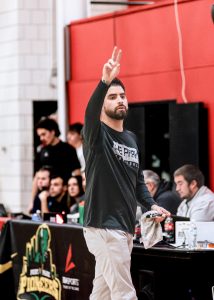Students successfully push for changes to Point Park’s academic plans this fall
September 2, 2020
The road to developing Point Park’s health and safety plan, let alone its academic plan, for students enrolled this semester has been long and involved. The university administration, however, has not been alone in developing its vision of how the university will operate this fall.
Dennis McDermott, president of the Student Government Association (SGA) along with several other student advocates, have been routinely meeting with Dean of Students and Vice President of Student Affairs, Keith Paylo, as well as President Paul Hennigan every week since early July. In these meetings, McDermott has sometimes partnered with Emily Harnett, Alex Frank and Sophie Burkholder to promote student concerns about returning to campus.
“Dennis and his colleagues, his fellow student leaders, have made it very clear to us what the interests of the students are and what the concerns of the students are,” Hennigan said in Point Park’s Student Town Hall on August 6. “And I will tell you that as a result of the approach that Dennis and his fellow student leaders have taken, they had a direct impact on our decision to transition to a Hyflex modality for the fall as well as the interim grading policy that we’re putting in place for the fall.”
In the middle of the spring 2019 semester, Point Park, along with many other universities in the world, scrambled to develop a plan to accommodate students’ and faculties’ learning needs while adapting to the COVID-19 pandemic. When it became apparent that the pandemic was not a temporary problem that would be resolved by the start of the fall semester, universities had more time over the summer to draft plans for how academics would be handled.
On July 7, Point Park released its initial “On Campus Learning And Operations” guide, totalling over 30 pages. In this first version, plans for grading and learning were not as clear cut. There was no provision for all-remote learning throughout the entirety of the fall 2020 semester, although it did include the current policy of all classes being taught remotely following Thanksgiving Break and a proviso for all classes to be moved to exclusively online learning should the circumstances call for that decision. Additionally, pass/no credit would not be offered for virtually any class, as it had been in the spring 2019 semester.
McDermott said students’ concerns about this first version of the plan came “right away” on social media.
“…there were many students upset about the plan, felt it wasn’t detailed enough, and we were a month away, and we did not feel safe enough about going onto campus,” McDermott said. “I recognized it for the problem that it was; this is an emergency, tuition is due in less than a month, people have to figure out their loan companies and they don’t even know if they want to be at Point Park.”
In meeting with the COVID-19 Student Committee, a subcommittee of the Student Government Association formed shortly after the pandemic started, McDermott and SGA members discussed changes students wanted to see to the university’s plan. The COVID-19 Tip Sheet, created by Alex Frank, detailed students’ most pressing interests for the fall semester, including creating an all-online option for the entire semester and extending pass/no credit into the fall semester among other concerns about health and safety. The list circulated around social media and student leaders like McDermott presented it to Hennigan, Paylo and Assistant Provost Dr. Jonas Prida.
According to Prida, pass/no credit was originally only going to be offered the spring 2019 semester due to the wildly uncertain circumstances teachers and students found themselves in. At that time, many local universities and others nationwide were adopting pass/no credit policies as a temporary grading measure, but most have reverted to standard policies for the upcoming academic year.
However, Prida said that McDermott was able to argue a strong case on students’ behalf for why this policy was still necessary for the fall 2020 semester.
“That was all driven by student concerns and I mean that legitimately, especially coming out of this semester. Part of me was extremely happy for Dennis and his leadership in making this happen. He did a great job of letting all of us in the meeting know that this was an important position for students,” Prida said. “And so it was really easy in some ways just to say yes because when students advocate that much for their own learning, it’s kind of what you want.”
Other students have been emailing him about the pass/no credit option as well, which Prida said lent credence to McDermott’s argument that this was an important policy to still offer for students.
Point Park is not the only university in the country continuing a version of pass/no credit. Princeton University and the University of Massachusetts Amherst are two notable institutions that have extended the policy into the fall semester as well.
There are currently no plans on extending pass/no credit into subsequent semesters, but Prida said since a pass/no credit policy exists in the university’s handbook, that it is easy to adjust and potentially extend. While the pass/no credit option seems like the perfect solution for students’ grading woes during the pandemic, Prida does warn that there could be side effects from opting too many classes for pass/no credit.
“So that’s one of the potential long term implications of having pass/no credit go on for two or three semesters is a student might take multiple no credits and then that shows up weirdly on your transcript,” Prida said. “It also might extend time towards graduation because a student, instead of taking a “D” in the course which will still get you credits, decides that they’re going to take the “N” (no credit) version of it. And so that student might end up having to be in university for another semester, another semester and a half and so there starts to be some financial implications there and so I think that’s why it’s important to sort of look at this long term and not just as a thing that solves a temporary problem quickly.”
Pass/no credit will be offered through a much similar process like last semester, and students will be receiving more information about the process later in the semester.
To start, students will have to adjust to classes provided this fall before even considering pass/no credit. The learning model the university came up with was largely developed by an executive team, including Hennigan, Paylo and Provost John Pearson and inspired from similar models at other universities, namely Vanderbilt University.
The details of the learning model were originally published on Point Park’s website on July 17. At that time, the university said the plan had been updated to reflect the evolving nature of the pandemic situation and feedback received from faculty and students alike.
The model has been specifically adapted for Point Park’s programs, according to Prida. The model breaks down five different learning models: hyflex, hybrid, remote, blended and face-to-face. Hyflex classes will follow a more traditional path , meeting up online at the assigned class time every other week or so, while hybrid classes will involve more online activities done outside of a scheduled class. Blended learning will combine elements of hybrid and hyflex, but will likely be one of the least used options, according to Prida. Hyflex will be the default model for courses unless the faculty decides otherwise or the student has opted for all remote learning.
Having a remote learning option for the entirety of the semester was one of the demands on the COVID-19 Tip Sheet that was realized in this new announcement. Towards the end of July, the administration began sending emails explaining how students could use PointWeb to select any class to be remote for the semester. The university has maintained, however, that an “overwhelming majority” of students want on-campus classes.
“We disagree, me and university, about that to a point. I wouldn’t say it’s incorrect. A lot of people do want to be on campus,” McDermott said.
McDermott estimates around a little under half of students at Point Park want to be on campus, based on a survey he conducted of about 400 students. Of those who do want to be on campus, he said approximately 25 percent want all in-person courses with no accommodations and 25 percent want a hybrid. He said this survey reflects different results than the statistics the university is citing when they make these statements.
“The survey they’re referencing directly was taken at the end of the school year last semester,” McDermott said. “A lot of circumstances have changed since then, so I no longer think it’s accurate, so I really wish they would stop referencing it.”
In the town hall, Prida said about 15 percent of students had opted for all remote classes. By August 24, a few weeks after that town hall, around 25 to 27 percent of students had chosen to do all their classes remotely with a similar percentage of students deciding to take their classes all on campus. Prida also estimates around 50 percent are doing a mix of online and on-ground courses this fall.
Even with more options for learning and grading now available for students this fall, university administrators and student leaders are nonetheless encouraging students to bring forward any concerns. There is a current hashtag, #PPU4U, meant to bring attention to those issues.
“I’m a firm believer in a lot of the times the supposed problems to universities can be solved by listening to the students who go there,” Prida said.


















